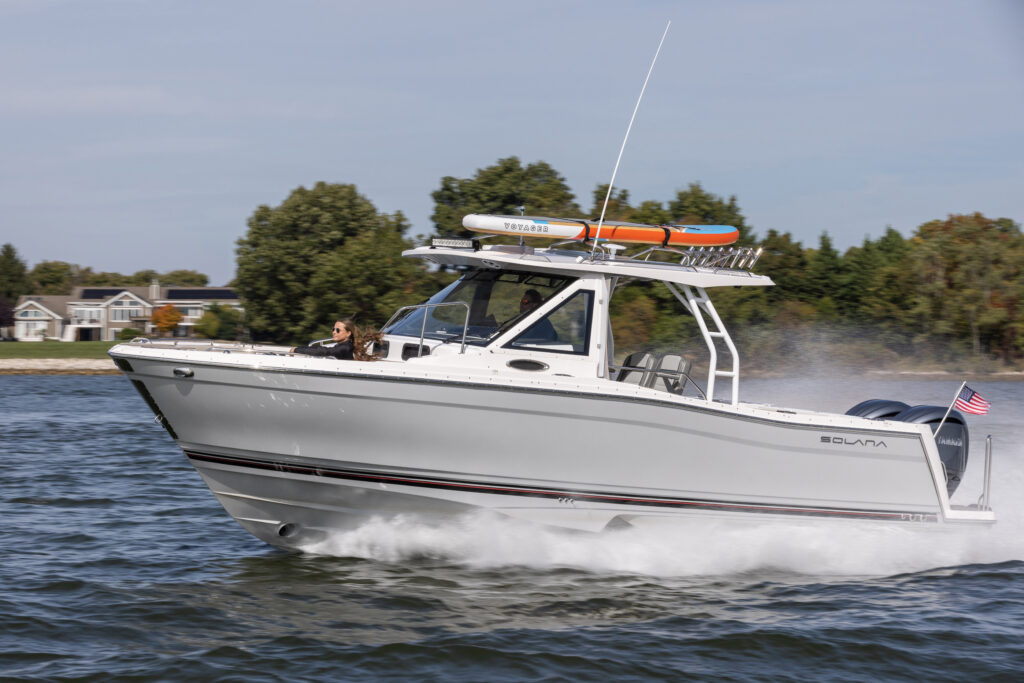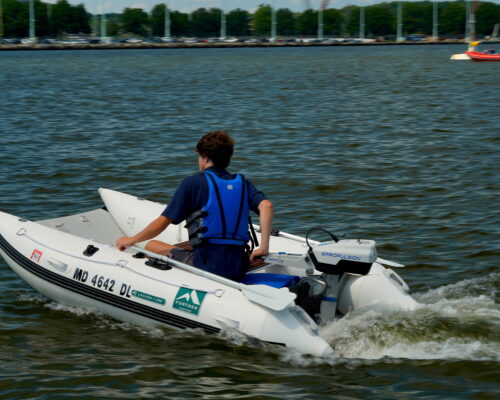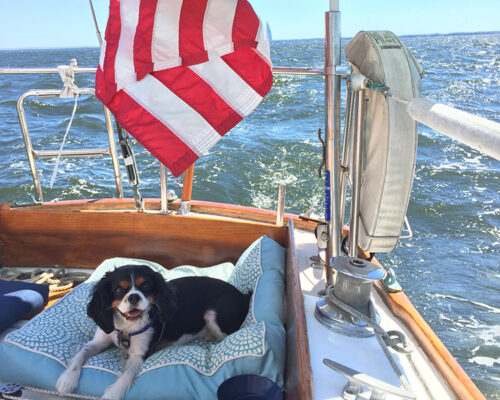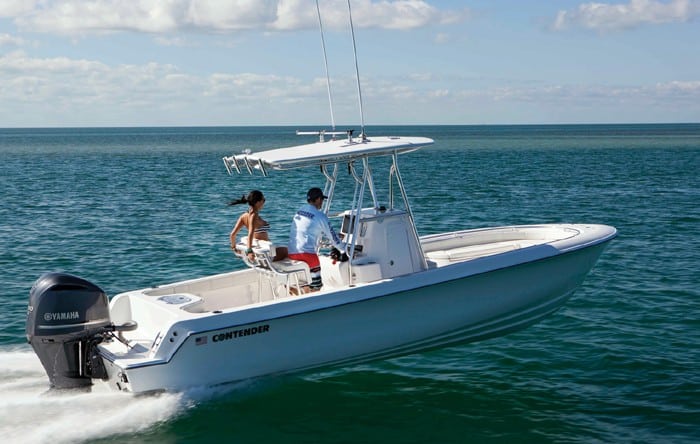Almost 60 years ago, one of my cousins brought a new kind of boat to our family’s collection of old cottages on the lower Potomac. It was a 16-foot MFG Beachcomber powered by a 40-hp Johnson outboard. Unlike his previous boats’ full bow decks and windshields, the Beachcomber had an open bow with seats on both sides, in front of a pair of windshields, with the helm behind the starboard windshield and a convertible companion/lounge seat beside the one to port. MFG called it a “bowrider.” We saw the bow cockpit as a great place to sit on family boat rides, with passengers in full view of the skipper and companion. It also became a useful place to stand to cast to surface-breaking rockfish and bluefish, and yes, it made for easy departures with the bow nosed into shore for beachcombing.
The MFG designers were clearly on to something. Though the boat brand disappeared in the 1980s, bowriders have proliferated ever since as runabouts. When built by fishboat companies like Grady-White, Cobia and Pursuit, we tend to call them “dual-consoles.” Either way, the basic layout serves especially well for family activities on the water. The boats, however, have gotten considerably larger and much more powerful, as families shift their water time from cabin cruisers to dayboats. Today’s bowriders/dual consoles take advantage of computer-aided design and weight analysis to produce hull forms that balance well even with half a dozen people in the bow cockpit and have enough flare molded in to keep them dry underway. The boats also now sport leisure features that would have put the most luxurious cabin cruisers of the 1960s to shame.
Trust the creative engineers at Fluid Motion in Auburn, Washington (also makers of Ranger Tugs and Cutwater Boats) to craft their own innovative variation on the basic bowrider layout, built to serve multiple pursuits among the bays, sounds, and islands of the Pacific Northwest on day trips and weekends. That is the “Center Walkaround” design in the company’s new Solara S-310 CW. Power is a pair of Yamaha F300s with Helm Master EX digital controls, plus an autopilot and a bow thruster. A joystick is one of the few options available for the well-equipped standard boat. We had an opportunity in late summer to run one on the Lynnhaven River’s Broad and Linkhorn bays, and we came away impressed with not only the boat’s broad versatility but also the level of detailed engineering that Fluid Motion’s designers have packed into this new model.
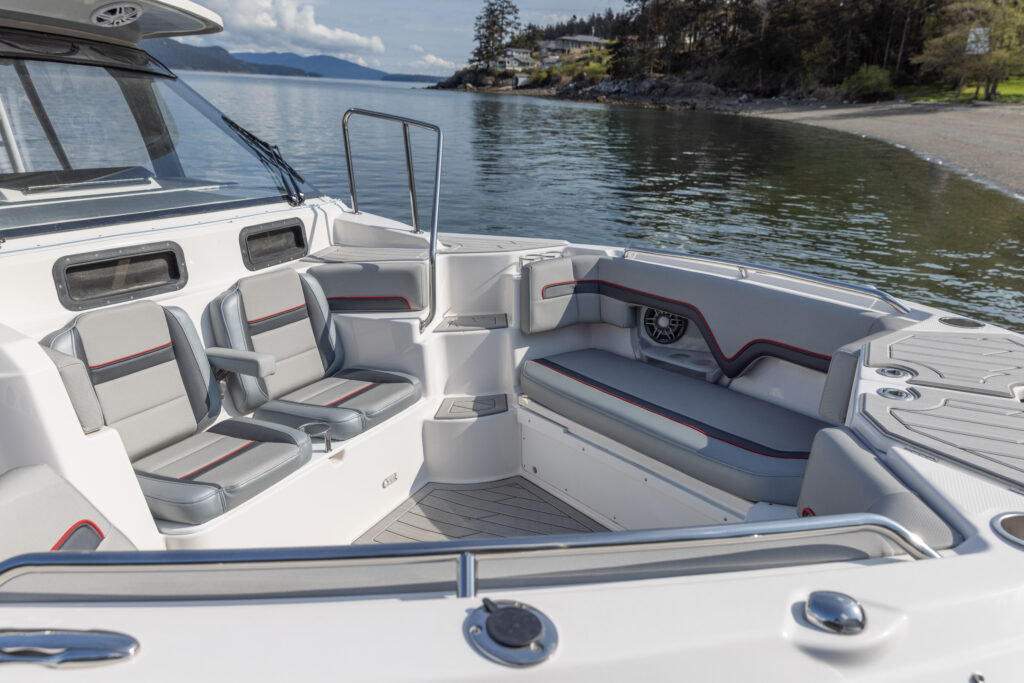
Our test boat’s owner, an experienced skipper who has owned multiple larger rigs, fills his S-310 CW with friends and family some weekends but also fishes the boat in the big, open waters around the mouth of the Chesapeake and even cruises her up the Bay as far as the lower Rappahannock. He especially likes the way she can carry six people comfortably in the deep bow cockpit, with seating for six more in the helm and companion chairs and the double folding benches at the transom and in the port hullside.
The boat’s basic layout centers around an asymmetrical deck plan with a large console amidships that extends three-quarters of the way across from the port rail, leaving a commodious 28-inch walkway to starboard. That leads to a deep, multi-use forward cockpit with two bucket seats in front of the console plus upholstered double benches port and starboard and storage beneath. A triangular table mounts in the sole. In the gunwale at the forward end of the walkway are a pair of beverage holders and three vertical rodholders for casting to breaking fish. Recessed into the topsides above the two benches are spaces for small gear and stereo speakers with controls.
In between, the bow deck holds hatches over an anchor windlass to port and a telescopic bow ladder to starboard for beaching. To port next to the console lie steps leading to a gunwale-top nonskid pad with a freestanding handrail for docking alongside a high wharf. It’s also possible to walk aft on a narrow nonskid path to the rear cockpit, while holding onto a cabintop rail. In typical PNW fashion, the cabintop includes a rack for kayaks, paddleboards or bikes, plus flats for mounting radar and other antennae, an innovative 8-rod rocket launcher on a pivot that allows lowering it for easy access and a cockpit floodlight.
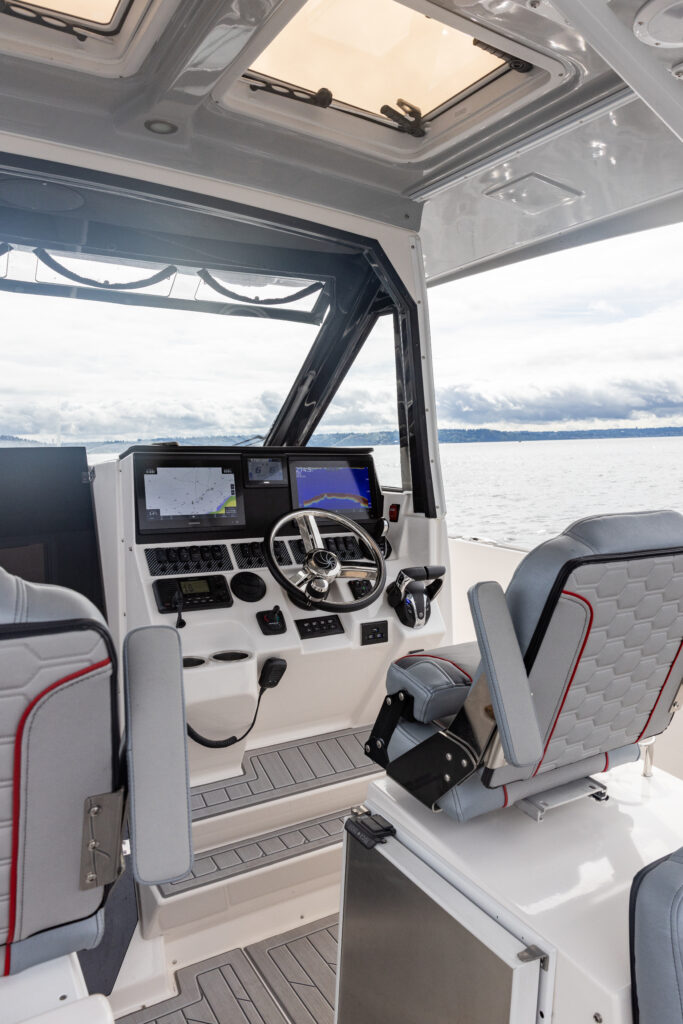
The helm holds a tilt steering wheel, with electronic controls for throttle/shift. Our test boat’s owner pointed out four opening, rectangular vents along the upper edge of the windshield, which provide welcome breezes underway on hot days. The dash also holds switches for twin windshield wipers, the autopilot, bow/stern cameras, a color engine display with digital fuel flow data, and a two-screen Garmin 8612xsv navigation system with GPS and sonar. Naturally, it also holds beverage holders and USB charging ports. The adjustable, bolstered helm seat offers an aft-facing seat behind. To port are twin companion seats, with a refrigerator/freezer beneath.
The companionway lies in between the helm and companion seats. It leads to a small but functional, lockable cabin inside the console, in the deepest part of the hull. The cabin has air conditioning and reverse cycle heat. The electrical system includes both 110- and 12-volt circuits, using shore power or a combination of a 3000w inverter and lithium-iron-phosphate batteries. We measured headroom at 6’2”, with 6’1” inside the enclosed head/shower to starboard. A V-berth forward measures 82” fore-and-aft, 92” along the sides. Above the berth to port are racks for three fishing rods. To port opposite the head is a small galley with countertop, microwave, Keurig coffeemaker, refrigerator/freezer and wine cooler. The cabin also provides a Fusion stereo system, a water heater, an LCD flat screen TV with antenna, LED lighting and opening portlights. Our test boat’s owner reports that the cabin provided comfortable accommodations for a weekend cruise from Lynnhaven to a destination marina on the Rappahannock.
Aft of the helm and companion seats, the large cockpit offers an upholstered, folding double seat across the transom and another recessed in the port hullside. On the starboard hullside is a full cockpit helm for maneuvering while tending trolling lines. There’s a livewell in the starboard corner of the transom, with a hinged, latched door to the Clear Path swim/boarding platform. The center of the transom holds a fishbox/cooler and a sink, with an electric grill (for shore power) in the port corner. The after edge of the transom holds a retractable ski pylon on the centerline. The cockpit sole has five hinged hatches for access to capacious storage beneath. The Clear Path platform offers nonskid decking between the after side of the transom and the two F300 Yamahas. Neat, unobtrusive digital engine/control rigging keeps the footing unobstructed. The starboard platform holds a telescopic swim ladder under a nonskid hatch. Next to it is a handy freestanding, U-shaped stainless grab handle that makes netting fish or boarding from a floating dock secure and easy.
Fluid Motion’s engineers are all avid boaters. Their experience on the water translates to all of the carefully thought-out features on deck and below, along with the systems that support them. They also, however, spent plenty of time working on the hull and propulsion. The running bottom has a deep, wave-cleaving 24-degree deadrise, with wide, reversed chines for stability, three lifting strakes on each side and a sharp bow entry. It also has two steps across the forward end of the running bottom to provide a cushion of aerated water that reduces friction at speed. Meanwhile, Fluid Motion’s proprietary, circular Laminar Flow Interrupters in the bow keep the hull locked in during hard turns, functioning in the hull/water interface the way dimples do on a golf ball in flight. We were suitably impressed by how well they kept the hull planted in maneuvers at higher speeds.
With this setup and the strong, smooth Yamahas doing what they do, the S-310 CW (which weighs in at more than 10,500 pounds) topped out at 41 knots (5400 rpm), with its painted bottom and auto-leveling trim tab system limiting the revs. Disabling the trim tab system and trimming the engines out would allow them to reach their maximum of 6000, but higher speeds are seldom practical in a boat like this, whether in the Pacific Northwest or the Chesapeake. Instead, the system of steps, strakes, tabs and flow interrupters provides an impressively wide range of useful cruising speeds, from 14 knots (3000 rpm) to 34 (4500), to allow the skipper to adjust to sea conditions for both safety and comfort. The tester’s owner particularly likes to cruise at 4200 rpm (30 knots), which happens to provide peak efficiency and a range of 190 nautical miles.
Solara’s pricing policy includes nearly all of the features a prospective owner would want for a standard advertised cost. For the S-310 CW, that is $373,937. The only options a buyer might order for a Chesapeake boat are a joystick (though the standard boat maneuvers beautifully with twin engines and the bow thruster), a Garmin xHD radar, a 175w solar panel, and weather curtains around the console for extending the season in spring and fall. Otherwise, this modern vessel takes the bowrider concept to an extraordinary new range of Chesapeake capabilities. For more information, visit solaraboats.com. The local dealer for all Fluid Motion boat brands is Pocket Yacht Company, Grasonville, Maryland. (pocketyachtco.com).
CBM Editor-at-Large, educator, guide and author of three quintessential Chesapeake Bay books, Capt. John Page Williams was named a Maryland Admiral of the Bay in 2013.
Solara S-310 Console Walkaround
LOA: 30’10”
Beam: 10′
Draft: 25”
Weight: 10,500 lb. (dry)
Transom Deadrise: 24 degrees
Bridge Clearance: 8’4″/9’2″ (w/radar)
Fuel Cap: 200 gal
Water Cap: 41 gal
Waste Cap: 21 gal
Max Power: 600 hp

